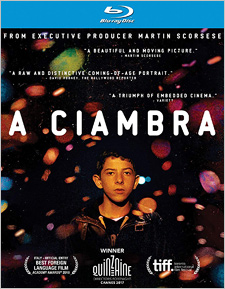A Ciambra (Blu-ray Review)

Director
Jonas CarpignanoRelease Date(s)
2017 (July 10, 2018)Studio(s)
Stayblack/RT Features/Rai Cinema/Sikelia/Academy Two (IFC Independent Films)- Film/Program Grade: B+
- Video Grade: B
- Audio Grade: B-
- Extras Grade: B
Review
A Ciambra, the second feature from director Jonas Carpignano (Mediterranea), takes place in the Ciambra, a strikingly poor and isolated neighborhood of Romani (Gypsies) and African migrants in the Calabria region of southern Italy. In the Romani section of the neighborhood, fourteen-year-old Pio Amato looks up to his father (Rocco Amato) and older brother Cosimo (Damiano Amato) and wants nothing more than their respect. Pio emulates them by smoking cigarettes, walking with a swagger, drinking, and serving an apprenticeship in thievery. The large, multi-generational Amato family talk loudly over one another and even the young children smoke and drink. The Italian police show up regularly to harass the residents.
The family makes ends meet until Pio’s father and brother are hauled off to serve short sentences in prison. Impatient to grow up and assert his masculinity, Pio regards himself now as the man of the household and primary breadwinner, and works diligently to prove he’s up to the challenge. He steals cars and sells them back to their owners, steals tech equipment, and even cases the home of an Italian crime family, which has serious consequences. Pio’s one friend and older brother substitute, Aviya (Koudous Seihon), is one of the Africans, an immigrant from Burkina Faso who watches over Pio.
A Ciambra is a rich portrait of a little-known society and its struggles to survive in the midst of poverty. Rather than being depressed at their lot, the family are spirited and close knit. Crime is simply a way of life — a method surviving a dreary neighborhood and a future without much hope. Director Carpignano keeps his focus small. The entire film takes place within the Ciambra, the only place Pio has ever known. Carpignano’s approach is documentary-like as mundane as well as more dramatic events unfold.
This neighborhood and its colorful characters are seen through the eyes of Pio. Young Mr. Amato has a sweet face that conveys innocence, inquisitiveness, and a twinkle of larceny as he suddenly must take on adult responsibilities, learning and stumbling along the way. Carpignano knows precisely when to hold on a close-up, as Pio contemplates a new problem or worries about how he will answer to his mother about the cash he gives her.
Iolanda Amato, Pio’s real-life and on-screen mother, is one of the best things in the movie. Completely natural, she is the family’s stern matriarch who knows how to smile and enjoy her family even when a little too much wine is poured. She may remind you of your mother, grandmother, aunt, or cousin. Iolanda is a nurturing presence, compensating for limited material means with a warm heart, unconditional love, and an irresistible earthiness.
The film’s primary drawback is its length, its story told in a series of episodes that affect Pio. The pace often drags after a scene has made its point. Some judicious cutting would have pared away unnecessary footage without sacrificing local color, the story, or characterization. At 119 minutes, the film feels a lot longer.
According to the accompanying making-of documentary, the movie was shot on location from May through August, 2016. Many of cinematographer Tim Curtin’s shots are taken with a hand-held camera, enhancing the movie’s documentary look. Working in actual locations, he had to resort to guerrilla filmmaking techniques frequently, because the modest budget prevented more traditional preparation. Rather than a negative, the look perfectly represents the community as it is, not glamorized or “prettied up” for the cameras. Shot in DTS-HD Master Audio, the sound is crisp, with a nice balance between dialogue and sound effects.
A Ciambra is presented by executive producer Martin Scorsese and was Italy’s official Best Foreign Language Film entry for the 2018 Academy Awards. The included featurette, A Ciambra: The Other Side of the Story informs us that the area’s low income housing was partly occupied before being finished. Electricity and sewers are still lacking. Today, the Romani community consists of approximately 700 people. Unlike many of Hollywood’s making-of featurettes, this short film provides a front row seat to director Carpignano’s freewheeling yet effective style of directing. His cast respects him and listens intently as he sets up a scene. Rather than watching talking heads, we’re up front and center as he directs various scenes.
Other bonus materials on the unrated widescreen Blu-ray release include the featurette From A Ciambra to Cannes, deleted scenes, a short film, and trailer. The film is in Italian, with English subtitles.
- Dennis Seuling

